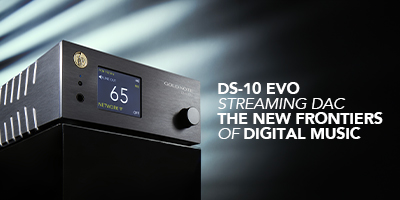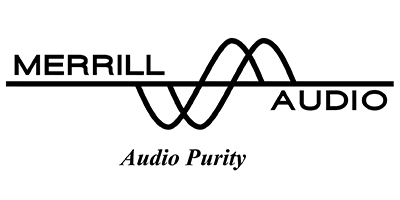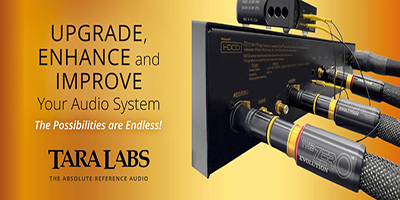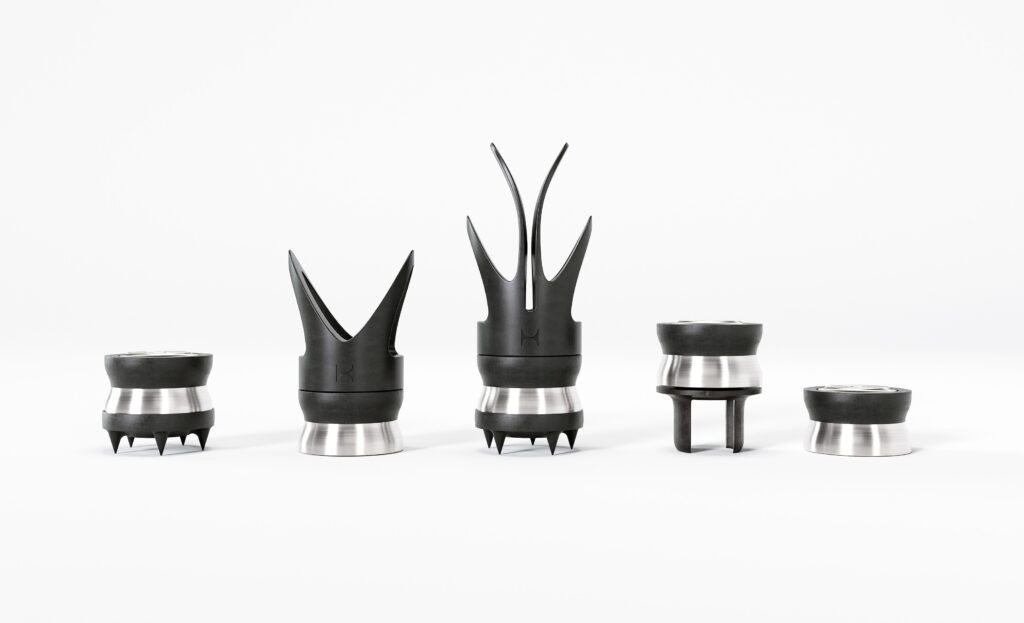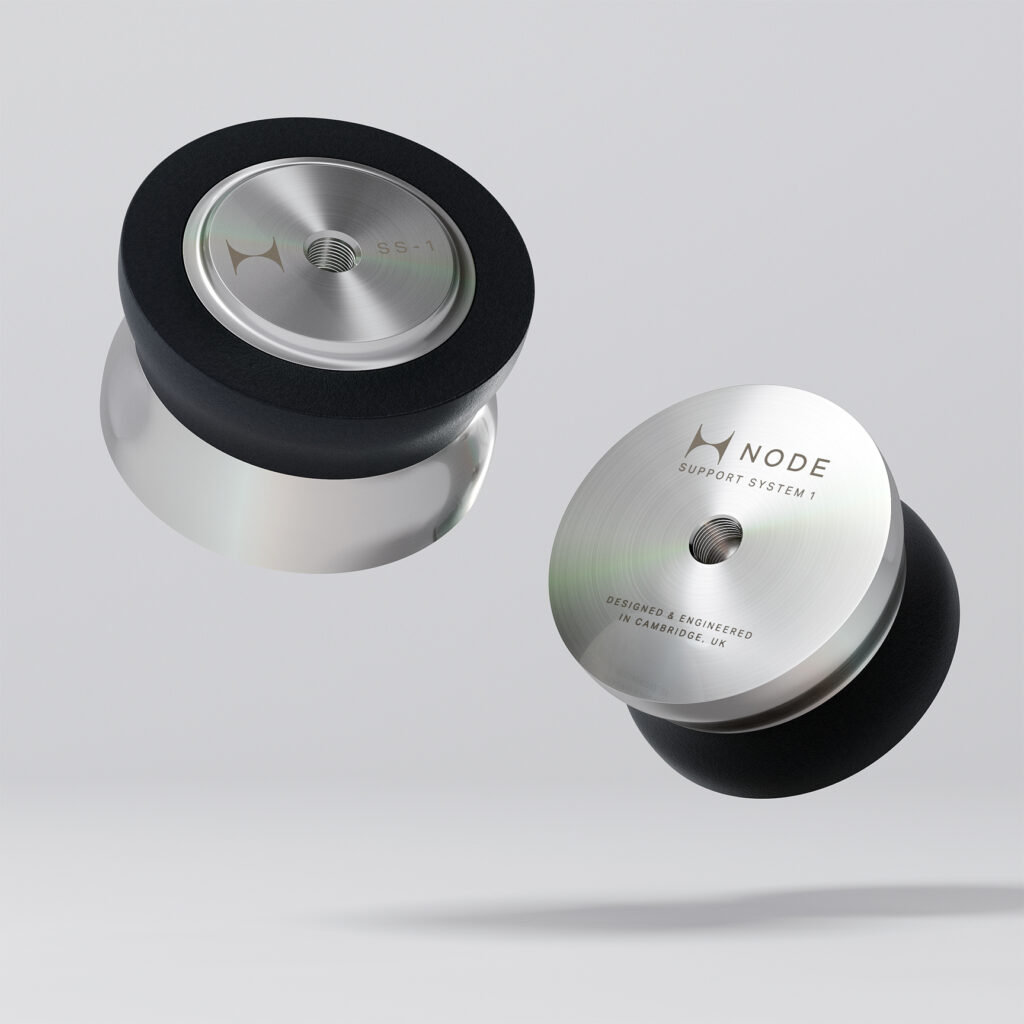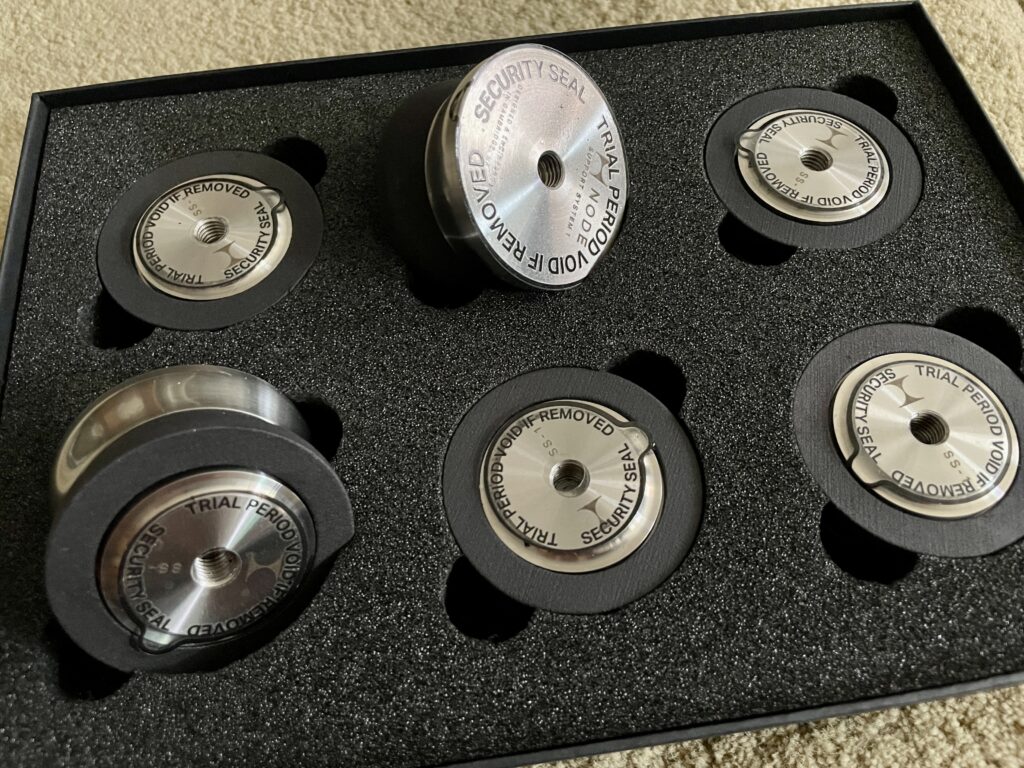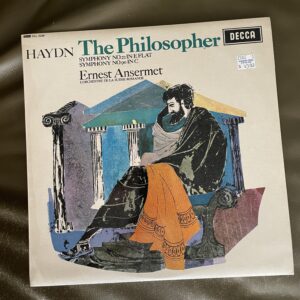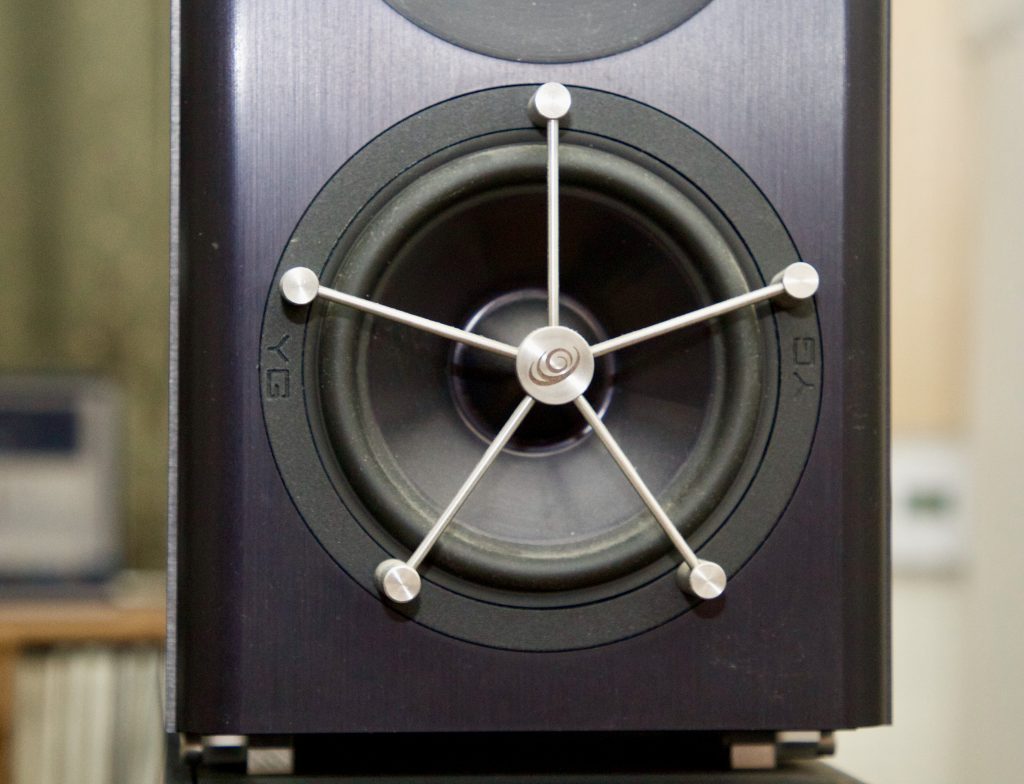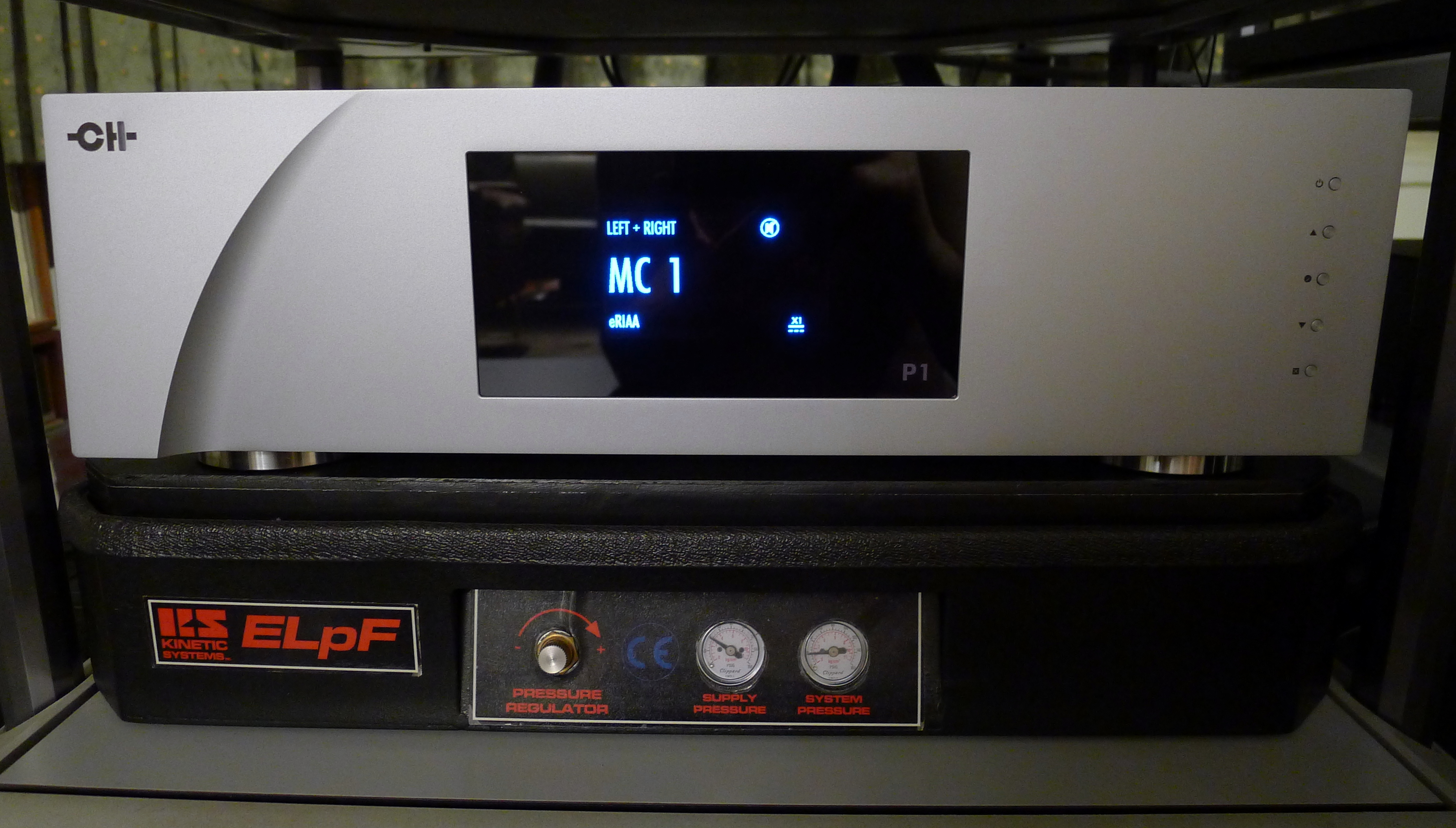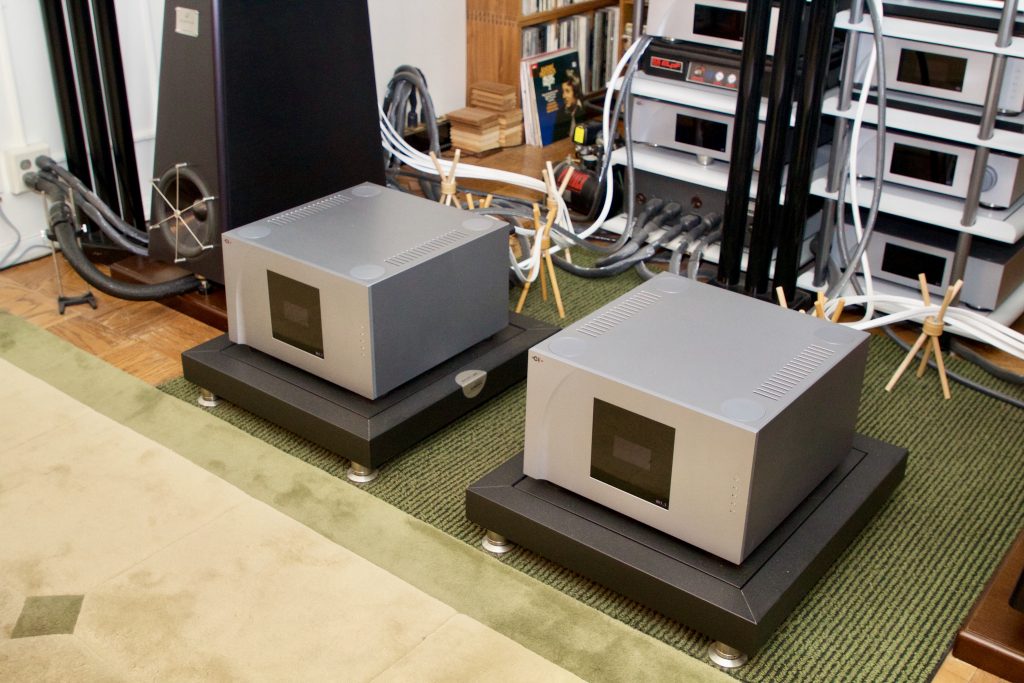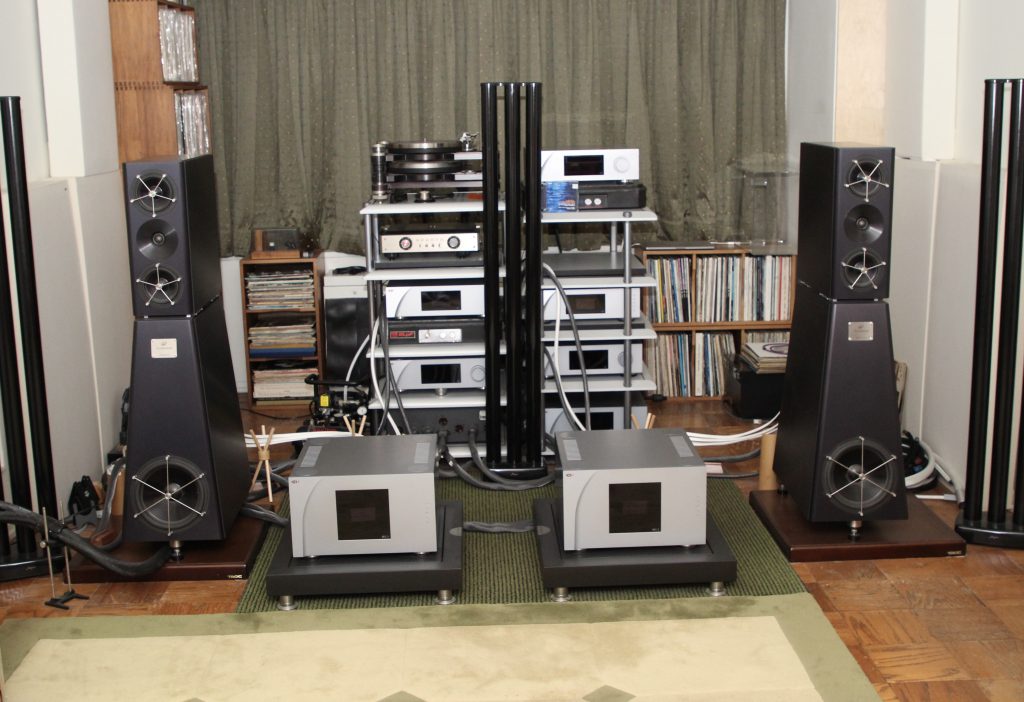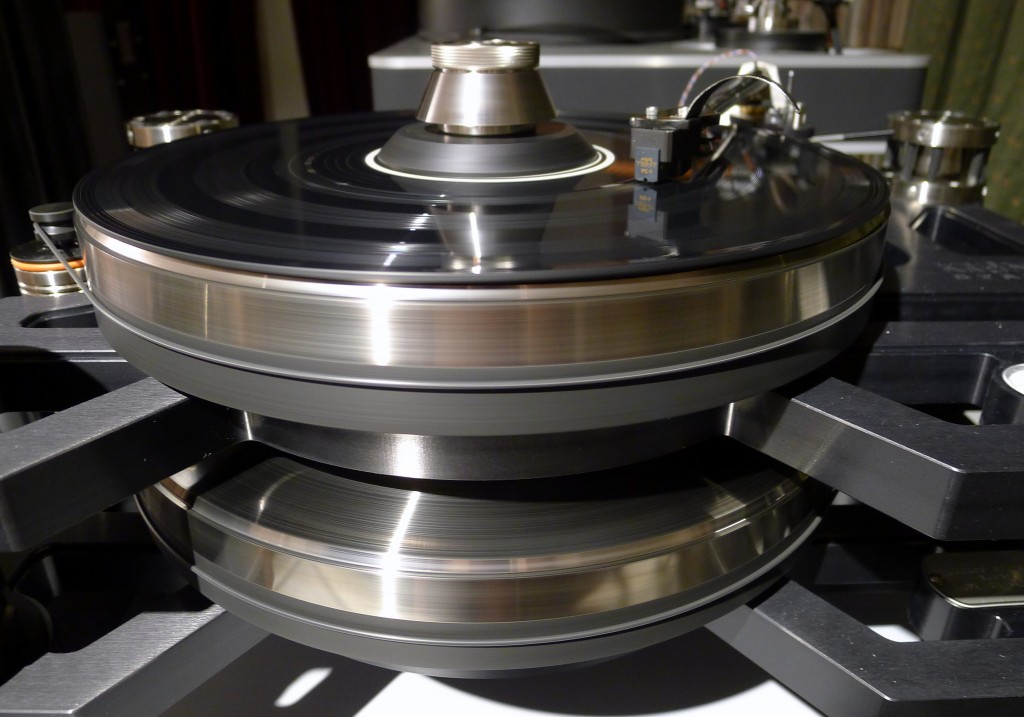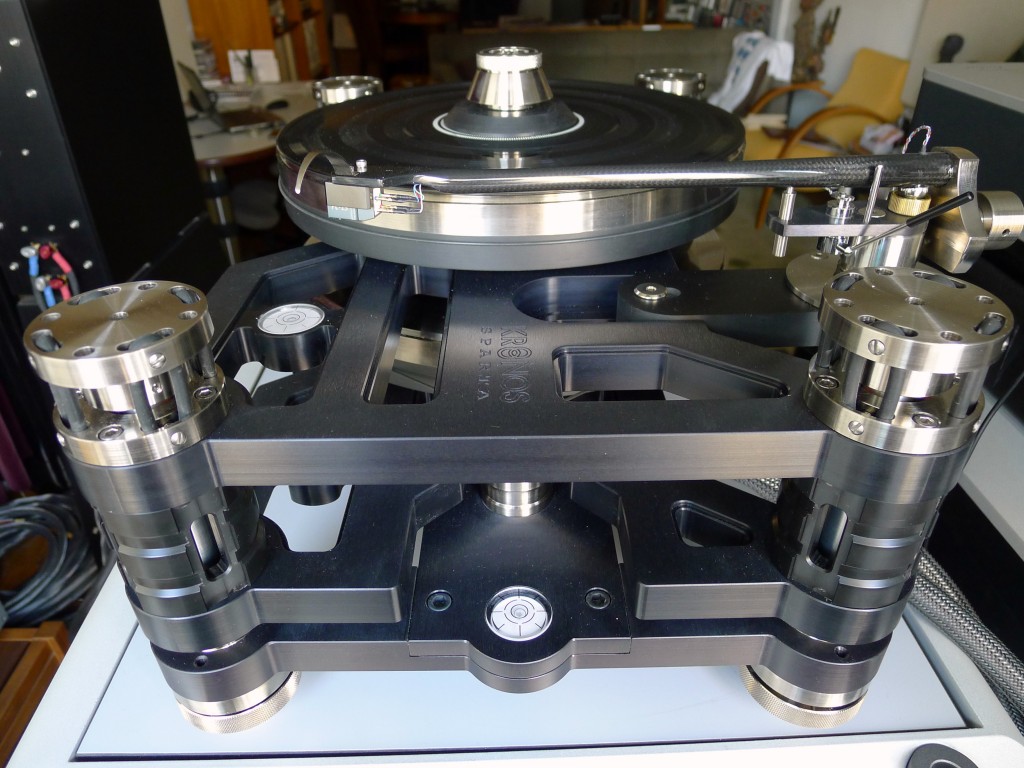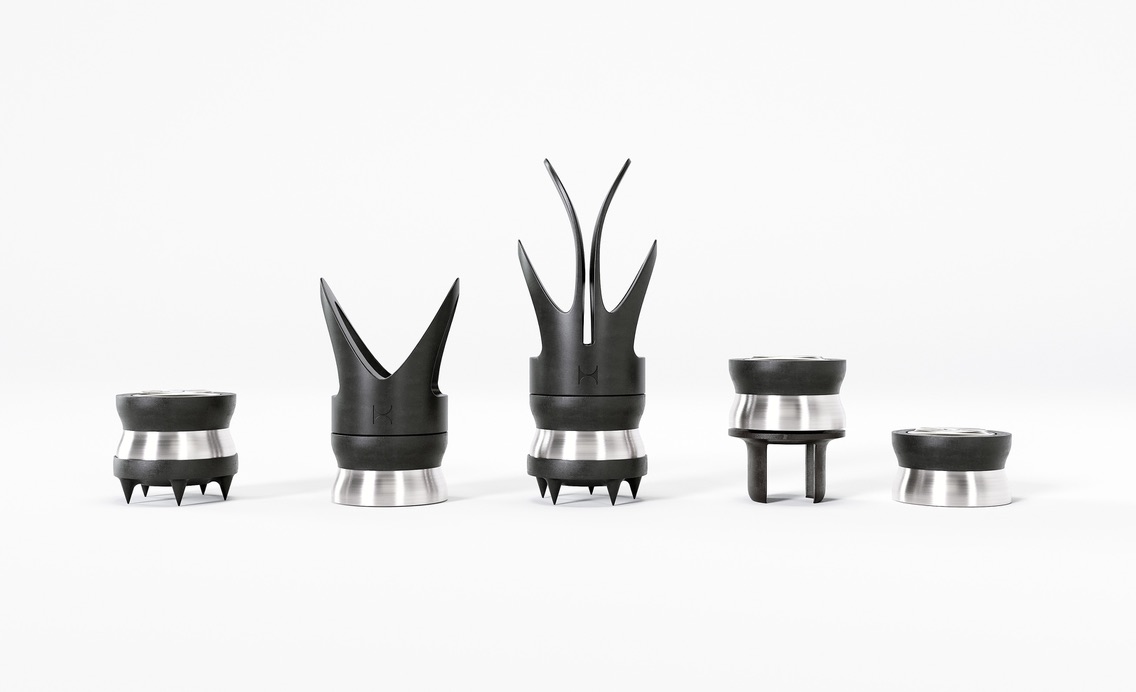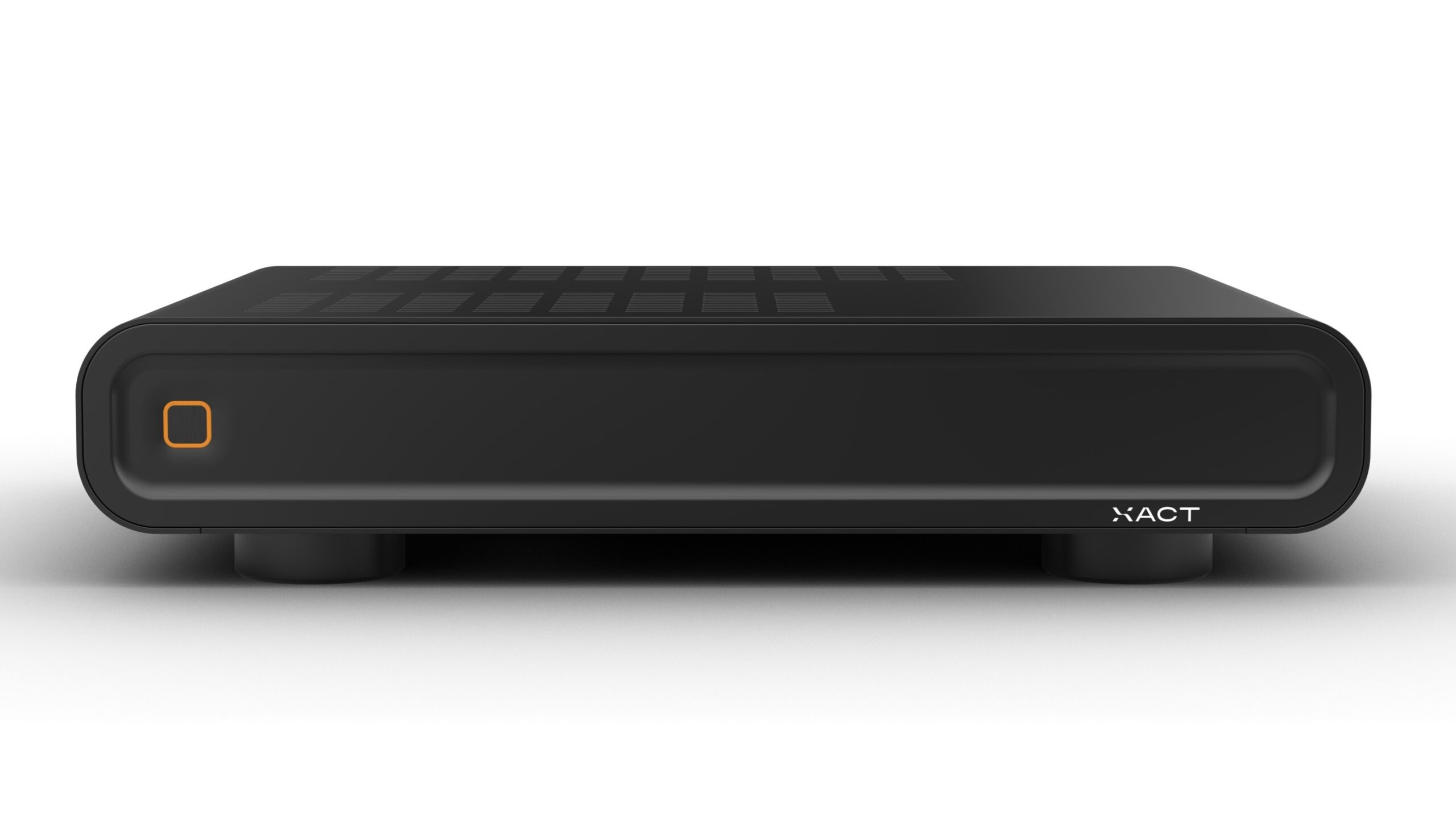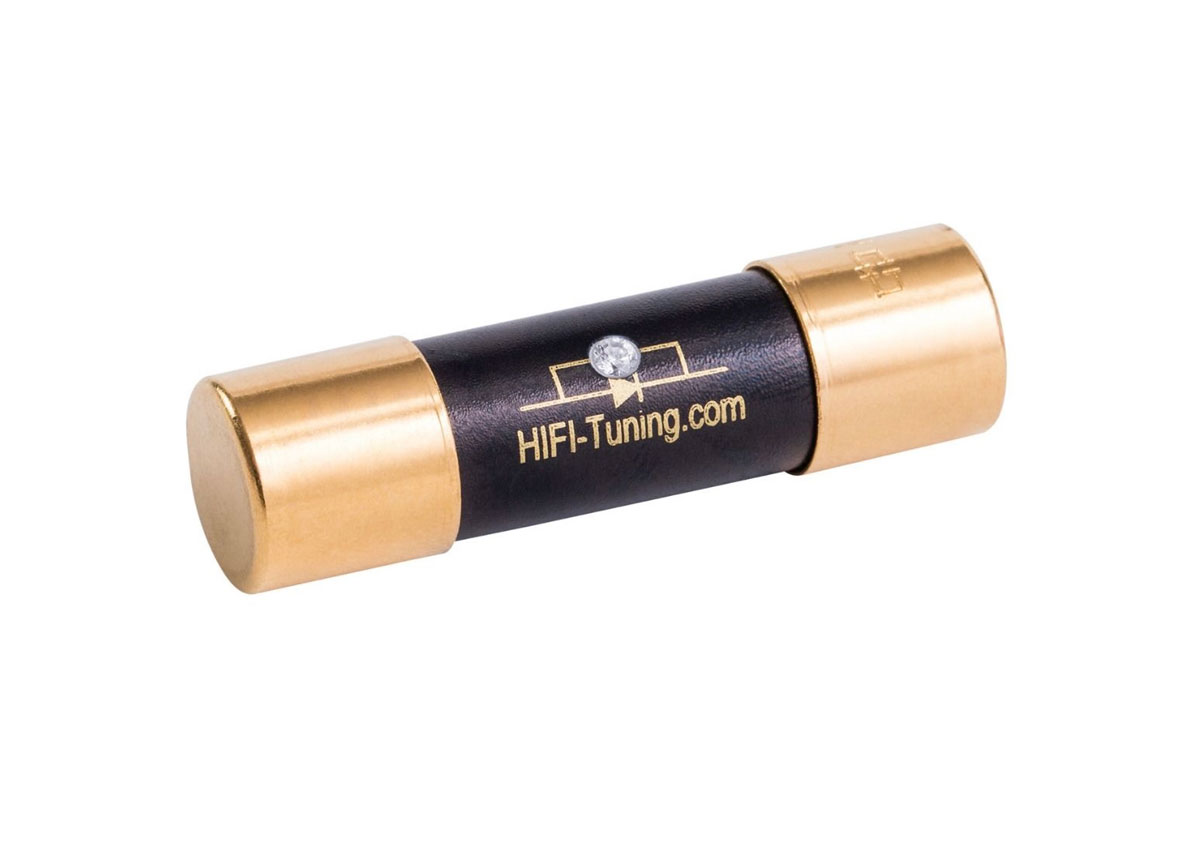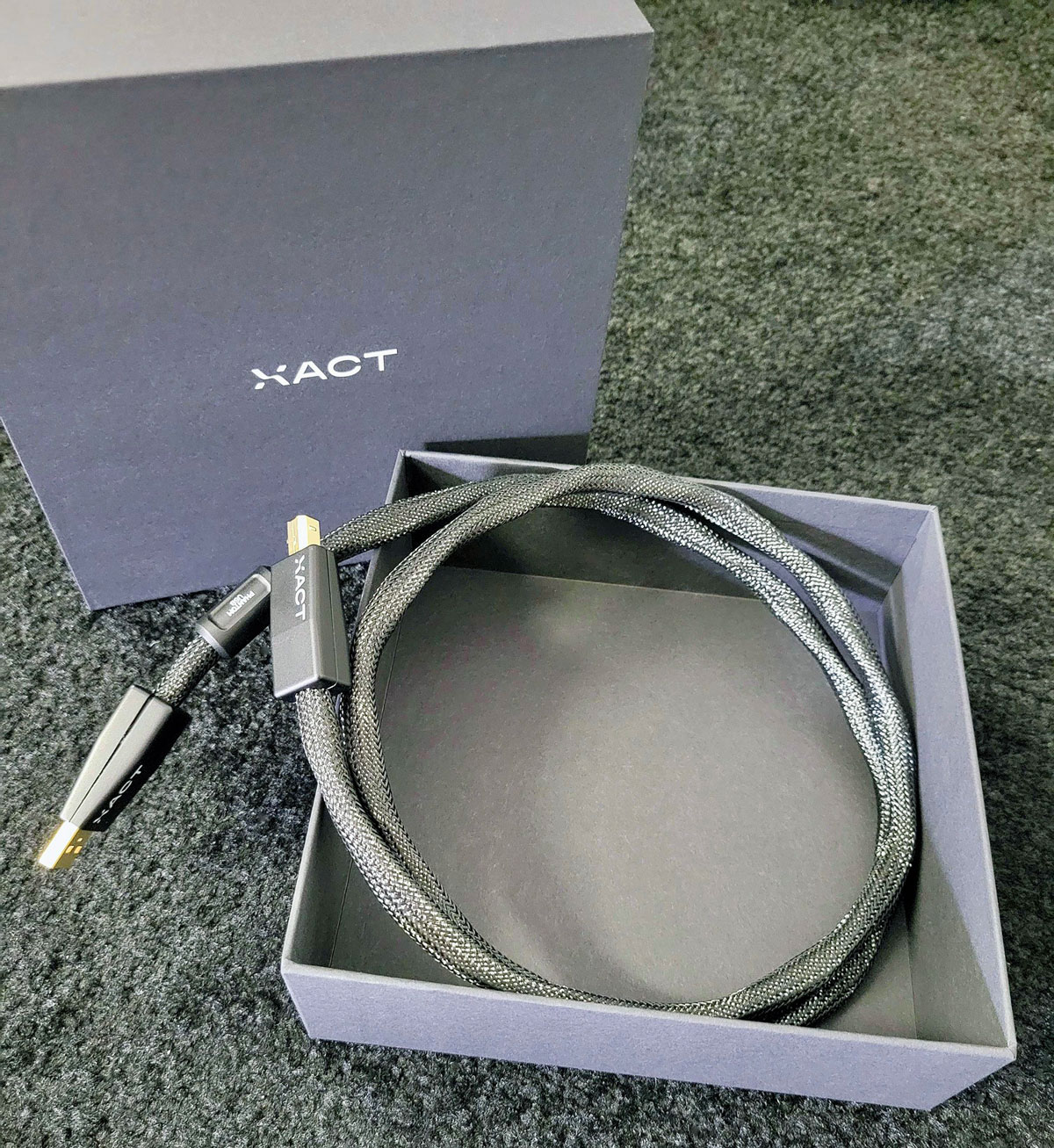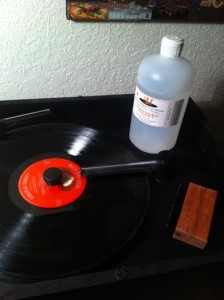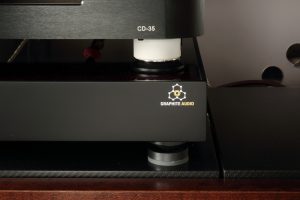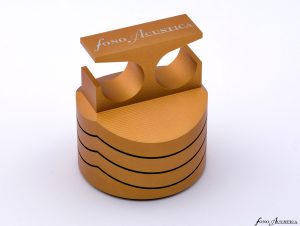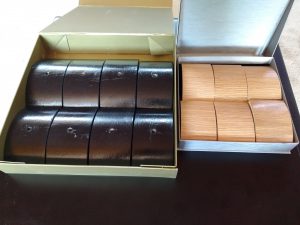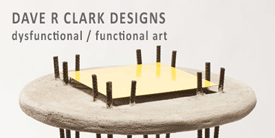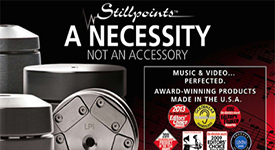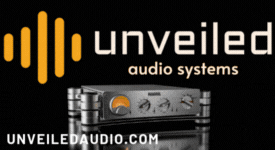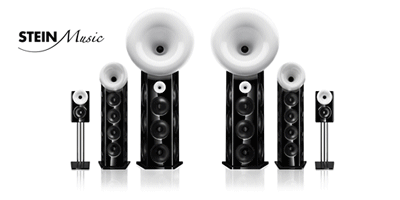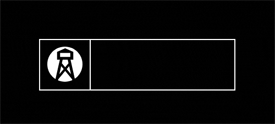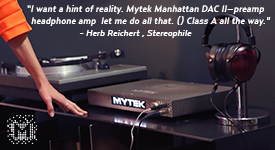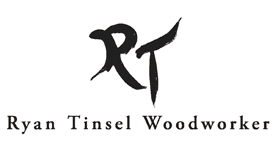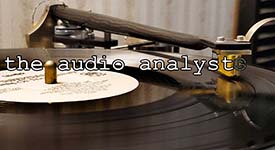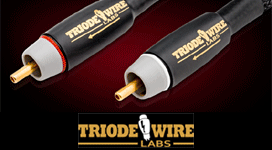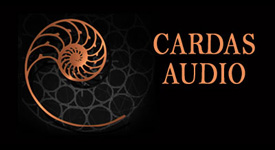While browsing the photo gallery on the Node Audio website, I came across a group shot of five finely crafted, elegantly designed objects. They appeared to be variations on a theme, but what was the theme—what were they used for? Sometimes you come upon objects that grab hold of your attention, yet their purpose remains elusive. I read the following description of the Support System One.
Welcome to SS-1, a modular component support eco-system that isolates equipment from its support, drains equipment vibrations, and focuses stray magnetic fields.
The heart of the system is the SS-1 module composite of machined stainless steel, laser sintered glass nylon and a ceramic core. When a component sits on the SS-1 it is isolated, drained of internal vibrations into the SS-1 ceramic core. The properties that make it a good component support also make it a good cable lift. A range of adapters and accessories allow it to serve double duty as a cable lift. One product that satisfies all your isolation support needs.
It took some time for that statement to sink in, but when it did, I had an "aha" moment. The leap was the assumption that component isolation and cable support present related challenges. If you accept this postulate, then theoretically, a single solution could address both. That is the concept behind the Node SS-1 base module. Standalone, it is a component footer. Attach an adapter, it transforms into a cable lift, a speaker support, a spider rack footer. I'm not aware of another product with a similar modular design. This is a new concept. Does it work? In this review, I'll evaluate the SS-1 as a component support. In a follow-up, I'll cover adding adapters that make it suitable to lift cables.
Active Materials or Passive?
The SS-1's materials list does not include dampening in any form, which is common in competing brands. Additionally, it doesn't mention any mysterious proprietary sound altering material, as found in products from Furutech, Nordost, and Synergistic. Yet, the SS-1 is claimed to enable the component to realize its full potential by creating a clear sonic path, which includes the reduction of EMI. The sonic signature of the component is intact, but it is operating more optimally. If the materials are passive, how does that come about? I reached out to Ashley May, one of the company's founders, and learned more (lightly edited):
Regarding your specific questions, we do not use any elastomers as damping materials. The gimbal movement of the top steel part ensures perfect contact to the equipment in question and facilitates the transfer of vibration down into a stack of ceramics. These are assembled into high tolerance channels in the lower piece of steel so the two materials are working in tandem as a vibrational drain.
The black outer shroud on top is manufactured from glass nylon, and it exists to reject airborne vibrations from entering the unit, allowing that energy to move to the lower steel component. We do not make any claims about RFI specifically, however EMF is controlled by using a particular grade of stainless steel with just enough ferrous content to limit the spread of stray EMF from the likes of transformers leaching into sensitive audio circuits. Hence, positioning under equipment can make a big difference.
Resonance Control in Audio — Flat or Pointy?
Before I get to the music, let's go over how resonances and vibrations are controlled in my reference CH Precision components. All CH gear have the same built-in isolation system. The design involves heavy steel rods with sharp spike tips that are inserted into openings at the four corners on top of the chassis, until the spike protrudes at the bottom, where a flat Delrin spike plate receives it. The contact between the component and the shelf are these four spike points, providing sturdy support, easy leveling, and good resonance control. It's a brilliant design and meticulously engineered. I haven't met a third-party footer that beats it.
The contact surfaces on the SS-1, on the other hand, are flat on both ends. The bottom is made of steel; the top is a steel gimbal surrounded by a black outer shroud of glass nylon. The component rests on the gimbal, which affords it a small amount of shimmy movement. This design is remarkably innovative and skillfully executed. Audiophiles have strong opinions regarding the sonic merits of spike points vs. flat contact surfaces.
Placement Guidance
Following the manufacturer's recommendations, the primary targets are between power supplies, large transformers, and delicate circuits. I pulled up the schematic for my CH Precision L1 Preamp and located the main transformer with the power supply right behind it, approximately at the center of the left edge, where I placed an SS-1. The second SS-1 went under the power supply regulation board below the front panel display, while a third was placed towards the rear to balance the preamp's weight on the shelf.
I pushed play. The sound lit up. Who turned on the stage lights? The contrast was markedly enhanced, like being in the recording studio control room. I'm sure this may appeal to some audiophiles, but my preference is natural borders. I began to inch the SS-1 away from the transformer area, closer to the component's edge. Each adjustment reduced the contrast and filled in the midrange, gradually transitioning to an acoustic ambiance—until it over corrected and I had to back off. Footer placement can bring a wide spectrum of effects, anything from startling to subtle. The SS-1 are powerful and can assist you in dialing-in the sound you want. This may not be considered an optimal use of an adult's time by the general public—I would exercise caution before mentioning this to non-audiophiles. Nevertheless, it is highly worthwhile to experiment. It should be noted that the SS-1 changes the sound by removing impediments that prevent optimum performance, which is not to be confused with accessories that impart their own sonic signature. The design brief prioritized neutrality.
One by one, I lifted and listened to the remaining components of my CH Precision front-end. When I got to the CH X1 external power supply I use for the DAC and phono stage, the schematic showed two big transformers inside. Four footers were needed for the X1: two under the transformers and two for the component's stability on the shelf. With SS-1s placed slightly offset from the transformer's center, the impact was the most significant by far.
What I hear with my Front-End Components Lifted
With all of my front-end components supported by SS-1s, my thoughts turned to PRaT, soundstaging, and purity. The second movement of Symphony No. 90 on Haydn The Philosopher (Decca SXL 6226, original LP) is marked andante, indicating a walking tempo. But this was no leisurely stroll through the park. I noticed right away the faster pace. This walker was counting steps and noting the elapsed time. It was clear that the quickened pace was due to improved alignment of the transients.
Transient coherency affects everything. When you remove the hazy edge, instrumental attacks become brisk and assertive. Low strings gain greater authority, while the first and second violins respond with nearly equal force. Low-level information surfaces, facilitating easy instrument identification. In general, when the SS-1 are placed optimally, the low end acquires more heft and grip; the treble is smoother without loss of detail; tonal density intensifies; the image size slightly expands; dimensional cues become more explicit; and the sound becomes purer. Nothing is artificially enhanced or forced; it simply sounds natural. As Lynn observed, "Did it always have those inner voices and that presence?" If you remove the SS-1s, the music takes on a slower, more lumbering pace.
Be Cautious of Over-Control
EMI/RFI remediation has emerged as a hotbed of activity in recent years. Numerous third-party products are available to address these gremlins and, once you taste them, you'll want to keep going. I've accumulated quite an assortment, such as RCA and XLR caps for unused connectors on components, the Nordost QKORE ground noise reduction unit, the Fono Acustica Compas Speaker Ground System, and the Audio Realignment Technologies mats. The Node Audio SS-1 also addresses EMI and joins this group. Indeed, there is some overlap in their effects.
If you've traveled this road, you know that EMI mitigation efforts are cumulative. Keep adding devices and eventually you will hit a tipping point, where aspects of the performance that are supposed to be present get absorbed along with noise byproducts. The soundstage becomes scrubbed clean, detailed, and remarkably holographic, but it lacks bloom and color. The instruments no longer sound lifelike… you've gone too far. It's time to reduce the amount of remediation.
I've installed sixteen SS-1s under my front-end gear. Micro dynamics, detail retrieval, timbral color, and instrument body—all just kept getting better. But to accommodate the SS-1s, I had to remove many of those other tweaks. After extensive experimentation, the optimum arrangement was the SS-1s below every component with a reduced number of ART mats placed on top—approximately half of the initial quantity. The ART mats have been my primary weapon to date. The SS-1 don't work the same or sound the same as the ART mats, but are equally effective in combating EMI. When combined, a powerful synergy develops that surpasses their individual capabilities. I'm tempted to call this dual-product "sandwich" positioned above and below the component the total solution. It achieved a major advance in sound quality.
Conclusion
There's a contingent of audiophiles who purchase an entire system from a dealer they trust. Setup is usually included, and when the installation is complete, the dealer leaves. No further fiddling around, no A/B testing, now it's time to enjoy your purchase. As Lynn often asks when I'm tweaking things, "If it sounds good, don't fix it. What happened to leaving well enough alone?"
While this approach may suffice for some, it should not be mistaken for the ultimate goal. This will only take you nine-tenths of the way there. The missing percent is due to the assumption that products developed and tested under factory conditions or heard in dealer showrooms will perform up to spec in your home. That will never be the case. Each listening room presents unique challenges.
To fully realize the potential of your purchases, you have to identify and address these issues. This is where I have to counter with the argument that tweaks and accessories are essential. For example, the component-audio rack interface is known to cause unpredictable issues. The Node Audio SS-1 component footers are very effective in this assignment. When you install the SS-1, you'll be rewarded with increasingly complex, natural sound. They are better than other footers I've tried and the first to out-perform the built-in isolation system of my CH Precision gear. They're not going back to the manufacturer.
In a follow-up review, I'll delve into the SS-1 plus adapters that make this system suitable as a cable lift for power cords and speaker wire.
Short Node Introductory Video
www.node-audio.com/ss-1-introduction
SS-1 Module
Retail: $450/ea
SS-1 Module + Rack Mount
Retail: $490/ea
SS-1 Module + Power Cable Support
Retail: $600/ea
SS-1 Module + Spkr Cable Support
Retail: $640/ea
Carpet Spikes
Retail: $40/ea
Node Audio
Distributor information
Aaudio Imports

